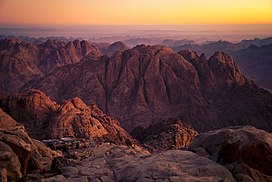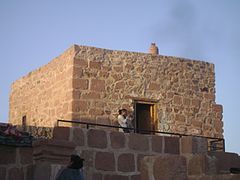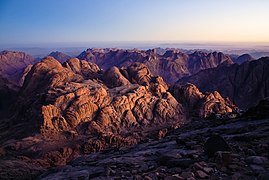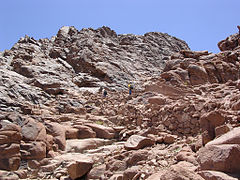| Mount Sinai | |
|---|---|
| Egyptian Arabic: جَبَل مُوسَىٰ, romanized: Gabal Mūsā Arabic: جَبَل مُوْسَى, romanized: Jabal Mūsā Coptic: Ⲡⲧⲟⲟⲩ Ⲥⲓⲛⲁ Classical Syriac: ܛܘܪܐ ܕܣܝܢܝ Ṭūrāʾ Dsyny Ancient Greek: Ὄρος Σινά Latin: Mons Sinai Hebrew: הַר סִינַי | |
 The summit of Mount Sinai The summit of Mount Sinai | |
| Highest point | |
| Elevation | 2,285 m (7,497 ft) |
| Prominence | 334 m (1,096 ft) |
| Coordinates | 28°32′21.9″N 33°58′31.5″E / 28.539417°N 33.975417°E / 28.539417; 33.975417 |
| Naming | |
| Native name | |
| Geography | |
 | |
Mount Sinai (Hebrew: הַר סִינַי Har Sīnay; Aramaic: ܛܘܪܐ ܕܣܝܢܝ Ṭūrāʾ dəSīnăy; Coptic: Ⲡⲧⲟⲟⲩ Ⲥⲓⲛⲁ), also known as Jabal Musa (Arabic: جَبَل مُوسَىٰ, translation: Mountain of Moses), is a mountain on the Sinai Peninsula of Egypt. It is one of several locations claimed to be the biblical Mount Sinai, the place where, according to the Torah, Bible, and Quran, Moses received the Ten Commandments.
It is a 2,285-meter (7,497 ft), moderately high mountain near the city of Saint Catherine in the region known today as the Sinai Peninsula. It is surrounded on all sides by higher peaks in the mountain range of which it is a part. For example, it lies next to Mount Catherine which, at 2,629 m or 8,625 ft, is the highest peak in Egypt.
Geology

Mount Sinai's rocks were formed during the late stage of the evolution of the Arabian-Nubian Shield. Mount Sinai displays a ring complex that consists of alkaline granites intruded into diverse rock types, including volcanics. The granites range in composition from syenogranite to alkali feldspar granite. The volcanic rocks are alkaline to peralkaline, and they are represented by subaerial flows and eruptions and subvolcanic porphyry. Generally, the nature of the exposed rocks in Mount Sinai indicates that they were formed at different depths from one another.
Religious significance
Judaism and Christianity
Main article: Mount Sinai (Bible)Immediately north of the mountain is the 6th-century Saint Catherine's Monastery. The summit has a mosque that is still used by Muslims, and a Greek Orthodox chapel, constructed in 1934 on the ruins of a 16th-century church, that is not open to the public. The chapel encloses the rock which is considered to be the source for the biblical Tablets of Stone. At the summit also is "Moses' cave", where Moses was said to have waited to receive the Ten Commandments.
Islam
The Jabal Musa is associated with the Islamic prophet Mūsā ibn ʿImrān (i.e., Moses). In particular, numerous references to Jabal Musa exist in the Quran, where it is called Ṭūr Saināʾ, Ṭūr Sīnīn, and aṭ-Ṭūr and al-Jabal (both meaning "the Mount"). As for the adjacent Wād Ṭuwā (Valley of Tuwa), it is considered as being muqaddas (sacred), and a part of it is called Al-Buqʿah Al-Mubārakah ("The blessed Place"). It is the place where Musa spoke to his Lord.
-
Saint Catherine's Monastery, looking down from Mount Sinai
-
 The mosque at the summit
The mosque at the summit
-
 The chapel at the summit
The chapel at the summit
Ascent and summit
There are two principal routes to the summit. The longer and shallower route, Siket El Bashait, takes about 2.5 hours on foot, though camels can be used. The steeper, more direct route (Siket Sayidna Musa) is up the 3,750 "steps of penitence" in the ravine behind the monastery.
 A panoramic view from the summit of Mount Sinai
A panoramic view from the summit of Mount Sinai
See also
- Hashem El Tarif
- Sacred mountains
- Jebel Musa, Morocco, a similarly named mountain in Morocco
References
- "Sinai Geology". AllSinai.info. Archived from the original on 2011-07-18. Retrieved 2006-08-29.
- Hanaa M. Salem and A. A. ElFouly, "Minerals Reconnaissance at Saint Catherine Area, Southern Central Sinai, Egypt and their Environmental Impacts on Human Health" Archived 2012-06-01 at the Wayback Machine. ICEHM2000, Cairo University, Egypt, September 2000, pp. 586–98
- "Mount Sinai, Egypt". Places of Peace and Power. Archived from the original on 2011-02-24. Retrieved 2006-08-29.
- Sharīf, J.; Herklots, G. A. (1832). Qanoon-e-Islam: Or, The Customs of the Moosulmans of India; Comprising a Full and Exact Account of Their Various Rites and Ceremonies, from the Moment of Birth Till the Hour of Death. Parbury, Allen, and Company.
koh-e-toor.
- Abbas, K. A. (1984). The World is My Village: A Novel with an Index. Ajanta Publications. Archived from the original on 2023-12-28. Retrieved 2021-06-01.
- Quran 23:20
- Quran 95:2
- Quran 2:63–93
- ^ Quran 28:3–86
- Quran 7:103–156
- Quran 20:9–99
- Quran 79:15–25
- Ibn Kathir (2013-01-01). Dr Mohammad Hilmi Al-Ahmad (ed.). Stories of the Prophets: [قصص الأنبياء [انكليزي. Dar Al Kotob Al Ilmiyah (Arabic: دَار الْـكُـتُـب الْـعِـلْـمِـيَّـة). ISBN 978-2745151360. Archived from the original on 2023-12-28. Retrieved 2021-06-01.
- Elhadary, Osman (2016-02-08). "11, 15". Moses in the Holy Scriptures of Judaism, Christianity and Islam: A Call for Peace. BookBaby. ISBN 978-1483563039.
- "Mount Sinai". AllSinai.info. Archived from the original on 2011-07-18. Retrieved 2006-08-29.
External links
 Mount Sinai travel guide from Wikivoyage
Mount Sinai travel guide from Wikivoyage- Caucasian Albanian Alphabet Discovered and Deciphered, Azerbaijan International, Vol. 11:3 (Autumn 2003). Six articles.
- View OF Mount Sinai (as opposed to the view FROM Mount Sinai) Archived 2020-10-10 at the Wayback Machine
- Information about the town of St. Katherine and the Sinai mountains
- A Report on Mount Sinai
- Old maps of Mount Sinai. Eran Laor Cartographic Collection, The National Library of Israel.
| People and things in the Quran | |||||||||||||||||||||||||||||||||||||||||||||||||||||||||||||||||||||||||||||
|---|---|---|---|---|---|---|---|---|---|---|---|---|---|---|---|---|---|---|---|---|---|---|---|---|---|---|---|---|---|---|---|---|---|---|---|---|---|---|---|---|---|---|---|---|---|---|---|---|---|---|---|---|---|---|---|---|---|---|---|---|---|---|---|---|---|---|---|---|---|---|---|---|---|---|---|---|---|
| |||||||||||||||||||||||||||||||||||||||||||||||||||||||||||||||||||||||||||||
| |||||||||||||||||||||||||||||||||||||||||||||||||||||||||||||||||||||||||||||
| |||||||||||||||||||||||||||||||||||||||||||||||||||||||||||||||||||||||||||||
| |||||||||||||||||||||||||||||||||||||||||||||||||||||||||||||||||||||||||||||
| Note: Names are sorted alphabetically. Standard form: Islamic name / Biblical name (title or relationship) | |||||||||||||||||||||||||||||||||||||||||||||||||||||||||||||||||||||||||||||
| Ark of the Covenant topics | |
|---|---|
| People | |
| Lid | |
| Contents | |
| Locations | |
| Related |
|
| Ten Commandments | |
|---|---|
| Tablets of Stone · Finger of God · Ritual Decalogue | |
| Commandments |
|
| Topics | |
| In art |
|
| Media | |
| Related | |


